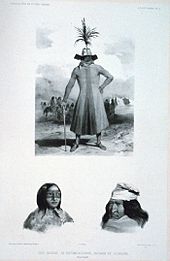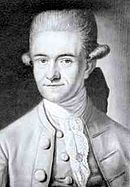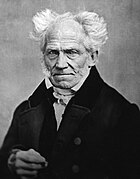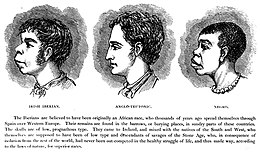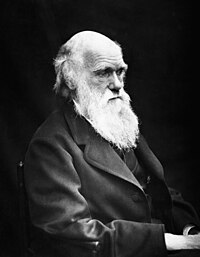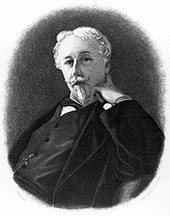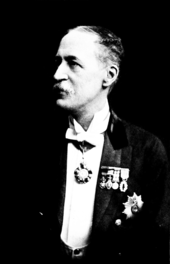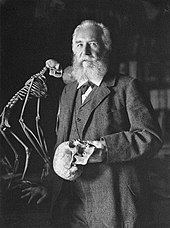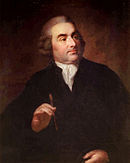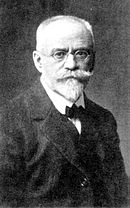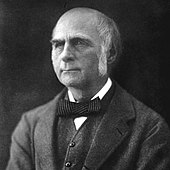Illustration from Types of Mankind (1854), whose authors Josiah Clark Nott and George Robins Gliddon implied that "Negroes" were a creational rank between "Greeks" and chimpanzees.
Scientific racism (sometimes referred to as race biology), is the pseudoscientific belief that empirical evidence exists to support or justify racism (racial discrimination), racial inferiority, or racial superiority. Historically, scientific racist ideas received credence in the scientific community but are no longer considered scientific.
Scientific racism employs anthropology (notably physical anthropology), anthropometry, craniometry, and other disciplines or pseudo-disciplines, in proposing anthropological typologies supporting the classification of human populations
into physically discrete human races, that might be asserted to be
superior or inferior. Scientific racism was common during the period
from 1600s to the end of World War I.
Since the second half of the 20th century, scientific racism has been
criticized as obsolete and discredited, yet historically has
persistently been used to support or validate racist
world-views, based upon belief in the existence and significance of
racial categories and a hierarchy of superior and inferior races.
After the end of World War II, scientific racism in theory and action was formally denounced, especially in UNESCO's early antiracist statement "The Race Question"
(1950): "The biological fact of race and the myth of 'race' should be
distinguished. For all practical social purposes 'race' is not so much a
biological phenomenon as a social myth. The myth of 'race' has created
an enormous amount of human and social damage. In recent years, it has
taken a heavy toll in human lives, and caused untold suffering". Such "biological fact" has not reached a consensus as developments in human evolutionary genetics showed that human genetic differences are often gradual.
The term "scientific racism" is generally used pejoratively as applied to more modern theories, as in The Bell Curve
(1994). Critics argue that such works postulate racist conclusions
unsupported by available evidence such as a connection between race and intelligence. Publications such as the Mankind Quarterly,
founded explicitly as a "race-conscious" journal, are generally
regarded as platforms of scientific racism for publishing articles on
fringe interpretations of human evolution, intelligence, ethnography, language, mythology, archaeology, and race subjects.
Antecedents
Enlightenment thinkers
During the Age of Enlightenment (an era from the 1650s to the 1780s), concepts of monogenism and polygenism became popular, though they would only be systematized epistemologically during the 19th century. Monogenism contends that all races have a single origin, while polygenism is the idea that each race has a separate origin. Until the 18th century, the words "race" and "species" were interchangeable.
Robert Boyle vs. Henri de Boulainvilliers
An early scientist who studied race was Robert Boyle (1627–1691), an Anglo-Irish natural philosopher, chemist, physicist, and inventor.
Boyle believed in what today is called 'monogenism', that is, that all
races, no matter how diverse, came from the same source, Adam and Eve. He studied reported stories of parents' giving birth to different coloured albinos,
so he concluded that Adam and Eve were originally white and that whites
could give birth to different coloured races. Theories of Robert Hooke and Isaac Newton about color and light via optical dispersion in physics were also extended by Robert Boyle into discourses of polygenesis,
speculating that maybe these differences were due to "seminal
impressions". However, Boyle's writings mention that at his time, for
"European Eyes", beauty was not measured so much in colour, but in "stature, comely symmetry of the parts of the body, and good features in the face". Various members of the scientific community rejected his views and described them as "disturbing" or "amusing".
On the other hand, historian Henri de Boulainvilliers (1658–1722) divided the French as two races: (i) the aristocratic "French race" descended from the invader Germanic Franks, and (ii) the indigenous Gallo-Roman race (the political Third Estate populace). The Frankish aristocracy dominated the Gauls by innate right of conquest.
In his time, Henri de Boulainvilliers,
a believer in the "right of conquest", did not understand "race" as
biologically immutable, but as a contemporary (racist) cultural
construct.[citation needed] His racialist account of French history was not entirely mythical: despite "supporting" hagiographies and epic poetry, such as The Song of Roland (La Chanson de Roland, c. 12th century), he sought scientific
legitimation by basing his racialist distinction on the historical
existence of genetically and linguistically distinguished Germanic and
Latin-speaking peoples in France. His theoretic racialism was distinct
from the biologic facts manipulated in 19th-century scientific racism.
Lord Kames
The Scottish lawyer Henry Home, Lord Kames (1696–1782) was a polygenist: he believed God had created different races on Earth in separate regions. In his 1734 book Sketches on the History of Man,
Home claimed that the environment, climate, or state of society could
not account for racial differences, so the races must have come from
distinct, separate stocks.
Carl Linnaeus
Homo monstrosus, or Patagonian giants, from Voyage au pole sud et dans l'Océanie (Voyage to the South Pole, and in Oceania), by Jules Dumont d'Urville
Carl Linnaeus (1707–1778), the Swedish physician, botanist, and zoologist, modified the established taxonomic bases of binomial nomenclature for fauna and flora, and was a pioneer researcher in biologically defining human race. In Systema Naturae (1767), he labeled five "varieties" of human species.
Each one was described as possessing the following physiognomic characteristics "varying by culture and place":
- The Americanus: red, choleraic, righteous; black, straight, thick hair; stubborn, zealous, free; painting himself with red lines, and regulated by customs.
- The Europeanus: white, sanguine, browny; with abundant, long hair; blue eyes; gentle, acute, inventive; covered with close vestments; and governed by laws.
- The Asiaticus: yellow, melancholic, stiff; black hair, dark eyes; severe, haughty, greedy; covered with loose clothing; and ruled by opinions.
- The Afer or Africanus: black, phlegmatic, relaxed; black, frizzled hair; silky skin, flat nose, tumid lips; females without shame; mammary glands give milk abundantly; crafty, sly, lazy, cunning, lustful, careless; anoints himself with grease; and governed by caprice.
- The Monstrosus were mythologic humans which didn't appear in the first editions of Systema Naturae. The sub-species included the "four-footed, mute, hairy" Homo feralis (Feral man); the animal-reared Juvenis lupinus hessensis (Hessian wolf boy), the Juvenis hannoveranus (Hannoverian boy), the Puella campanica (Wild-girl of Champagne), and the agile, but faint-hearted Homo monstrosus (Monstrous man): the Patagonian giant, the Dwarf of the Alps, and the monorchid Khoikhoi (Hottentot). In Amoenitates academicae (1763), Linnaeus presented the mythologic Homo anthropomorpha (Anthropomorphic man), humanoid creatures, such as the troglodyte, the satyr, the hydra, and the phoenix, incorrectly identified as simian creatures.
There are disagreements about what was the basis for Linnaeus' human
taxa. On the one hand, the harshest critics say that the classification
not only was ethnocentric but seemed to be based upon skin-color. On the
other hand, Quintyn (2010) points out that some authors believe the
classification was based upon geographical distribution, being
cartographically based, and not hierarchical. Paleontologist Stephen Jay Gould (1994) argues that the taxa was "not in the ranked order favored by most Europeans in the racist tradition", and that Linnaeus' division was influenced by the medical theory of humors which said that a person's temperament may be related to biological fluids.
In the opinion of Kenneth A.R. Kennedy (1976), Linneus certainly
considered his own culture better, but his motives for classification of
human varieties were not race-centered. The Linnean Society of London has stated that in Linnaeus' view, "Europeans' superiority resides in "culture", and that the decisive factor in Linnaeus' taxa was "culture", not race. Thus, regarding this topic, they consider Linnaeus view as merely "eurocentric",
arguing that Linnaeus never called for racist action, and did not use
the word "race", which was only introduced later "by his French opponent
Buffon". Scholar Stanley A. Rice agrees that Linnaeus' classification was not meant to "imply a hierarchy of humanness or superiority"; although modern critics see that his classification was obviously stereotyped, and erroneous for having included anthropological, non-biological features such as customs or traditions.
John Hunter
John Hunter (1728–1793), a Scottish surgeon,
said that originally the Negroid race was white at birth. He thought
that over time because of the sun, the people turned dark skinned, or
"black". Hunter also said that blisters and burns would likely turn
white on a Negro, which he believed was evidence that their ancestors
were originally white.
Charles White
Charles White (1728–1813), an English physician and surgeon, believed that races occupied different stations in the "Great Chain of Being",
and he tried to scientifically prove that human races have distinct
origins from each other. He believed that whites and Negroes were two
different species. White was a believer in polygeny, the idea that different races had been created separately. His Account of the Regular Gradation in Man (1799) provided an empirical basis for this idea. White defended the theory of polygeny by rebutting French naturalist Georges-Louis Leclerc, Comte de Buffon's
interfertility argument, which said that only the same species can
interbreed. White pointed to species hybrids such as foxes, wolves, and
jackals, which were separate groups that were still able to interbreed.
For White, each race was a separate species, divinely created for its
own geographical region.
Johann Friedrich Blumenbach
Buffon and Blumenbach
The French naturalist Georges-Louis Leclerc, Comte de Buffon (1707–1788) and the German anatomist Johann Blumenbach (1752–1840) were believers in monogenism,
the concept that all races have a single origin. They also believed in
the "degeneration theory" of racial origins. They both said that Adam and Eve were Caucasian
and that other races came about by degeneration from environmental
factors, such as the sun and poor dieting. They believed that the
degeneration could be reversed if proper environmental control was
taken, and that all contemporary forms of man could revert to the
original Caucasian race.
They thought Negroid pigmentation arose because of the heat of the tropical sun. They suggested cold wind caused the tawny colour of the Eskimos. They thought the Chinese
relatively fair skinned compared to the other Asian stocks because they
kept mostly in towns and were protected from environmental factors.
Buffon said that food and the mode of living could make races degenerate
and differentiate them from the original Caucasian race. According to Blumenbach, there are five races, all belonging to a single species: Caucasian, Mongolian, Ethiopian, American, and Malay. Blumenbach said:
"I have allotted the first place to the Caucasian for the reasons given below which make me esteem it the primeval one."
Buffon believed humanity was only 6000 years old (the time since Adam). Many scientific racialists pointed out at the time that it would have been difficult for races to change so markedly in genotype and phenotype
in such a short period of time. Believing in monogenism, Buffon thought
that skin colour could change in a single lifetime, depending on the
conditions of climate and diet.
Benjamin Rush
Benjamin Rush (1745–1813), a Founding Father of the United States and a physician,
proposed that being black was a hereditary skin disease, which he
called "negroidism", and that it could be cured. Rush believed
non-whites were really white underneath but they were stricken with a
non-contagious form of leprosy which darkened their skin color. Rush
drew the conclusion that "whites should not tyrannize over [blacks], for
their disease should entitle them to a double portion of humanity.
However, by the same token, whites should not intermarry with them, for
this would tend to infect posterity with the 'disorder'... attempts must
be made to cure the disease".
Christoph Meiners
Christoph Meiners
Christoph Meiners (1747–1810) was a German polygenist
and believed that each race had a separate origin. Meiner studied the
physical, mental and moral characteristics of each race, and built a
race hierarchy based on his findings. Meiners split mankind into two
divisions, which he labelled the "beautiful white race" and the "ugly black race". In Meiners's book The Outline of History of Mankind,
he said that a main characteristic of race is either beauty or
ugliness. He thought only the white race to be beautiful. He considered
ugly races to be inferior, immoral and animal-like. He said that the
dark, ugly peoples were distinct from the white, beautiful peoples by
their "sad" lack of virtue and their "terrible vices". According to Meiners,
The more intelligent and noble people are by nature, the more adaptable, sensitive, delicate, and soft is their body; on the other hand, the less they possess the capacity and disposition towards virtue, the more they lack adaptability; and not only that, but the less sensitive are their bodies, the more can they tolerate extreme pain or the rapid alteration of heat and cold; when they are exposed to illnesses, the more rapid their recovery from wounds that would be fatal for more sensitive peoples, and the more they can partake of the worst and most indigestible foods ... without noticeable ill effects.
Meiners said the Negro felt less pain than any other race and lacked
in emotions. Meiners wrote that the Negro had thick nerves and thus was
not sensitive like the other races. He went as far as to say that the
Negro has "no human, barely any animal, feeling". He described a story
where a Negro was condemned to death by being burned alive. Halfway
through the burning, the Negro asked to smoke a pipe and smoked it like
nothing was happening while he continued to be burned alive. Meiners
studied the anatomy of the Negro and came to the conclusion that Negroes have bigger teeth and jaws than any other race, as Negroes are all carnivores.
Meiners claimed the skull of the Negro was larger but the brain of the
Negro was smaller than any other race. Meiners claimed the Negro was the
most unhealthy race on Earth because of its poor diet, mode of living
and lack of morals.
Meiners also claimed the "Americans"
were an inferior stock of people. He said they could not adapt to
different climates, types of food, or modes of life, and that when
exposed to such new conditions, they lapse into a "deadly melancholy".
Meiners studied the diet of the Americans and said they fed off any kind
of "foul offal". He thought they consumed very much alcohol. He
believed their skulls were so thick that the blades of Spanish swords
shattered on them. Meiners also claimed the skin of an American is
thicker than that of an ox.
Meiners wrote that the noblest race was the Celts.
They were able to conquer various parts of the world, they were more
sensitive to heat and cold, and their delicacy is shown by the way they
are selective about what they eat. Meiners claimed that Slavs
are an inferior race, "less sensitive and content with eating rough
food". He described stories of Slavs allegedly eating poisonous fungi
without coming to any harm. He claimed that their medical techniques
were also backward: he used as an example their heating sick people in
ovens, then making them roll in the snow.
In Meiners's large work entitled Researches on the Variations in Human Nature (1815), he studied also the sexology
of each race. He claimed that the African Negroids have unduly strong
and perverted sex drives, whilst only the white Europeans have it just
right.
Later thinkers
Thomas Jefferson
Thomas Jefferson (1743–1826) was an American politician, scientist,
and slave owner. His contributions to scientific racism have been noted
by many historians, scientists and scholars. According to an article
published in the McGill Journal of Medicine: "One of the most
influential pre-Darwinian racial theorists, Jefferson’s call for science
to determine the obvious “inferiority” of African Americans is an
extremely important stage in the evolution of scientific racism." The historian Paul Finkelman described Jefferson in The New York Times
as follows: "A scientist, Jefferson nevertheless speculated that
blackness might come “from the color of the blood” and concluded that
blacks were “inferior to the whites in the endowments of body and mind.”" In his "Notes on the State of Virginia" Jefferson described black people as follows:
They seem to require less sleep. A black, after hard labor through the day, will be induced by the slightest amusements to sit up till midnight, or later, though knowing he must be out with the first dawn of the morning. They are at least as brave, and more adventuresome. But this may perhaps proceed from a want of forethought, which prevents their seeing a danger till it be present. When present, they do not go through it with more coolness or steadiness than the whites. They are more ardent after their female: but love seems with them to be more an eager desire, than a tender delicate mixture of sentiment and sensation. Their griefs are transient. Those numberless afflictions, which render it doubtful whether heaven has given life to us in mercy or in wrath, are less felt, and sooner forgotten with them. In general, their existence appears to participate more of sensation than reflection... Comparing them by their faculties of memory, reason, and imagination, it appears to me, that in memory they are equal to the whites; in reason much inferior, as I think one [black] could scarcely be found capable of tracing and comprehending the investigations of Euclid; and that in imagination they are dull, tasteless, and anomalous... I advance it therefore as a suspicion only, that the blacks, whether originally a distinct race, or made distinct by time and circumstances, are inferior to the whites in the endowments both of body and mind.
However, by 1791, Jefferson had to reassess his earlier suspicions of
whether blacks were capable of intelligence when he was presented with a
letter and almanac from Benjamin Banneker,
an educated black mathematician. Delighted to have discovered
scientific proof for the existence of black intelligence, Jefferson
wrote to Banneker:
No body wishes more than I do to see such proofs as you exhibit, that nature has given to our black brethren, talents equal to those of the other colors of men, & that the appearance of a want of them is owing merely to the degraded condition of their existence both in Africa & America. I can add with truth that no body wishes more ardently to see a good system commenced for raising the condition both of their body & mind to what it ought to be, as fast as the imbecility of their present existence, and other circumstance which cannot be neglected, will admit.
Samuel Stanhope Smith
Samuel Stanhope Smith (1751–1819) was an American Presbyterian Minister and author of Essay on the Causes of Variety of Complexion and Figure in the Human Species
in 1787. Smith claimed that Negro pigmentation was nothing more than a
huge freckle that covered the whole body as a result of an oversupply of
bile, which was caused by tropical climates.
Georges Cuvier
Georges Cuvier
Racial studies by Georges Cuvier (1769–1832), the French naturalist and zoologist, influenced scientific polygenism and scientific racism. Cuvier believed there were three distinct races: the Caucasian (white), Mongolian (yellow) and the Ethiopian
(black). He rated each for the beauty or ugliness of the skull and
quality of their civilizations. Cuvier wrote about Caucasians: "The
white race, with oval face, straight hair and nose, to which the
civilised people of Europe belong and which appear to us the most
beautiful of all, is also superior to others by its genius, courage and
activity".
Regarding Negroes, Cuvier wrote:
The Negro race ... is marked by black complexion, crisped or woolly hair, compressed cranium and a flat nose. The projection of the lower parts of the face, and the thick lips, evidently approximate it to the monkey tribe: the hordes of which it consists have always remained in the most complete state of barbarism.
He thought Adam and Eve
were Caucasian and hence the original race of mankind. The other two
races arose by survivors' escaping in different directions after a major
catastrophe hit the earth 5,000 years ago. He theorized that the
survivors lived in complete isolation from each other and developed
separately.
One of Cuvier's pupils, Friedrich Tiedemann,
was one of the first to make a scientific contestation of racism. He
argued based on craniometric and brain measurements taken by him from
Europeans and black people from different parts of the world that the
then-common European belief that Negroes have smaller brains, and are
thus intellectually inferior, is scientifically unfounded and based
merely on the prejudice of travellers and explorers.
Arthur Schopenhauer
Arthur Schopenhauer portrait
The German philosopher Arthur Schopenhauer
(1788–1860) attributed civilizational primacy to the white races, who
gained sensitivity and intelligence via the refinement caused by living
in the rigorous Northern climate:
The highest civilization and culture, apart from the ancient Hindus and Egyptians, are found exclusively among the white races; and even with many dark peoples, the ruling caste, or race, is fairer in colour than the rest, and has, therefore, evidently immigrated, for example, the Brahmins, the Inca, and the rulers of the South Sea Islands. All this is due to the fact that necessity is the mother of invention, because those tribes that emigrated early to the north, and there gradually became white, had to develop all their intellectual powers, and invent and perfect all the arts in their struggle with need, want, and misery, which, in their many forms, were brought about by the climate. This they had to do in order to make up for the parsimony of nature, and out of it all came their high civilization.
Franz Ignaz Pruner
Franz Ignaz Pruner
(1808–1882) was a medical doctor who studied the racial structure of
Negroes in Egypt. In a book which he wrote in 1846 he claimed that Negro
blood had a negative influence on the Egyptian moral character. He
published a monograph on Negroes in 1861. He claimed that the main
feature of the Negro's skeleton is prognathism,
which he claimed was the Negro's relation to the ape. He also claimed
that Negroes had very similar brains to apes and that Negroes have a
shortened big toe, which is a characteristic connecting Negroes closely
to apes.
Racial theories in physical anthropology, 1850–1918
A late-19th-century illustration by H. Strickland Constable shows an
alleged similarity between "Irish Iberian" and "Negro" features in
contrast to the higher "Anglo-Teutonic"
The scientific classification established by Carl Linnaeus is requisite to any human racial classification scheme. In the 19th century, unilineal evolution (a.k.a. classical social evolution) was a conflation of competing sociologic and anthropologic theories proposing that Western European culture was the acme of human socio-cultural evolution. The proposal that social status is unilineal—from primitive to civilized, from agricultural to industrial—became popular among philosophers, including Friedrich Hegel, Immanuel Kant, and Auguste Comte. The Christian Bible was interpreted to sanction slavery and from the 1820s to the 1850s was often used in the antebellum Southern United States, by writers such as the Rev. Richard Furman and Thomas R. Cobb, to enforce the idea that Negroes had been created inferior, and thus suited to slavery.
Charles Darwin
Charles Darwin in 1868
Charles Darwin's influential 1859 book On the Origin of Species did not discuss human origins. The extended wording on the title page, which adds by Means of Natural Selection, or the Preservation of Favoured Races in the Struggle for Life, uses the general term "races" as an alternative for "varieties" and does not carry the modern connotation of human races.
The first use in the book refers to "the several races, for instance,
of the cabbage" and proceeds to a discussion of "the hereditary
varieties or races of our domestic animals and plants". In The Descent of Man, and Selection in Relation to Sex
(1871), Darwin examined the question of "Arguments in favour of, and
opposed to, ranking the so-called races of man as distinct species" and
reported no racial distinctions that would indicate that human races are
discrete species:
It may be doubted whether any character can be named, which is distinctive of a race and is constant ... they graduate into each other, and ... it is hardly possible to discover clear, distinctive characters between them ... As it is improbable that the numerous, and unimportant, points of resemblance, between the several races of man, in bodily structure and mental faculties (I do not here refer to similar customs) should all have been independently acquired, they must have been inherited from progenitors who had these same characters.
Richard Weikart, in his book From Darwin to Hitler: Evolutionary Ethics, Eugenics and Racism in Germany (2004), claims:
Darwin clearly believed that the struggle for existence among humans would result in racial extermination. In Descent of Man he asserted, "At some future period, not very distant as measured by centuries, the civilised races of man will almost certainly exterminate and replace throughout the world the savage races".
According to talk.origins, this is a common creationist quote mine. They argue that when Darwin referred to "race" he meant "varieties", not human races,
as per the cabbage example cited above. Apart from the plain meaning of
the words, they assert "there is nothing in Darwin's words to support
(and much in his life to contradict) any claim that Darwin wanted the
'lower' or 'savage races' to be exterminated. He was merely noting what
appeared to him to be factual, based in no small part on the evidence of
a European binge of imperialism and colonial conquest during his
lifetime". The quoted passage, in full context, reads:
The great break in the organic chain between man and his nearest allies, which cannot be bridged over by any extinct or living species, has often been advanced as a grave objection to the belief that man is descended from some lower form; but this objection will not appear of much weight to those who, from general reasons, believe in the general principle of evolution. Breaks often occur in all parts of the series, some being wide, sharp and defined, others less so in various degrees; as between the orang and its nearest allies—between the Tarsius and the other Lemuridae between the elephant, and in a more striking manner between the Ornithorhynchus or Echidna, and all other mammals. But these breaks depend merely on the number of related forms which have become extinct. At some future period, not very distant as measured by centuries, the civilised races of man will almost certainly exterminate, and replace, the savage races throughout the world. At the same time the anthropomorphous apes, as Professor Schaaffhausen has remarked, will no doubt be exterminated. The break between man and his nearest allies will then be wider, for it will intervene between man in a more civilised state, as we may hope, even than the Caucasian, and some ape as low as a baboon, instead of as now between the negro or Australian and the gorilla.
— The Descent of Man (1871), Volume I, Chapter VI: "On the Affinities and Genealogy of Man", pp. 200–01
In the Chapter "On the Development of the Intellectual and Moral Faculties during Primeval and Civilised Times"
Darwin claimed that "the western nations of Europe, who now so
immeasurably surpass their former savage progenitors, and stand at the
summit of civilisation, owe little or none of their superiority to
direct inheritance from the old Greeks".
While proposing a sole human species, Darwin contrasted the
"civilized races" with the "savage races". Like most of his
contemporaries, except the naturalist Alfred Russel Wallace,
he did not distinguish "biological race" from "cultural race".
Moreover, he noted that savage races risked extinction more from white
European colonialism, than from evolutionary inadequacy.
On the question of differences between races, Darwin wrote:
There is, however, no doubt that the various races, when carefully compared and measured, differ much from each other,—as in the texture of the hair, the relative proportions of all parts of the body, the capacity of the lungs, the form and capacity of the skull, and even in the convolutions of the brain. But it would be an endless task to specify the numerous points of structural difference. The races differ also in constitution, in acclimatisation, and in liability to certain diseases. Their mental characteristics are likewise very distinct; chiefly as it would appear in their emotional, but partly in their intellectual, faculties. Every one who has had the opportunity of comparison, must have been struck with the contrast between the taciturn, even morose, aborigines of S. America and the light-hearted, talkative negroes. There is a nearly similar contrast between the Malays and the Papuans, who live under the same physical conditions, and are separated from each other only by a narrow space of sea.
Arthur de Gobineau
Portrait of Arthur de Gobineau by the Comtesse de la Tour, 1876
The French aristocrat and writer Arthur de Gobineau (1816–1882), is best known for his book An Essay on the Inequality of the Human Races (1853–55) which proposed three human races (black, white and yellow) were natural barriers and claimed that race mixing
would lead to the collapse of culture and civilization. He claimed that
"The white race originally possessed the monopoly of beauty,
intelligence and strength" and that any positive accomplishments or
thinking of blacks and Asians were due to an admixture with whites. His
works were praised by many white supremacist American pro-slavery
thinkers such as Josiah C. Nott and Henry Hotze.
Gobineau believed that the different races originated in
different areas, the white race had originated somewhere in Siberia, the
Asians in the Americas and the blacks in Africa. He believed that the
white race was superior, writing:
I will not wait for the friends of equality to show me such and such passages in books written by missionaries or sea captains, who declare some Wolof is a fine carpenter, some Hottentot a good servant, that a Kaffir dances and plays the violin, that some Bambara knows arithmetic… Let us leave aside these puerilities and compare together not men, but groups.
Gobineau later used the term "Aryans" to describe the Germanic peoples (la race germanique).
Gobineau's works were also influential to the Nazi Party, which published his works in German. They played a key role in the master race theory of Nazism.
Karl Vogt
Another polygenist evolutionist was Karl Vogt
(1817–1895) who believed that the Negro race was related to the ape. He
wrote the white race was a separate species to Negroes. In Chapter VII
of his lectures of man (1864) he compared the Negro to the white
race whom he described as "two extreme human types". The difference
between them, he claimed are greater than those between two species of
ape; and this proves that Negroes are a separate species from the
whites.
Herbert Hope Risley
Herbert Hope Risley
As an exponent of race science, Colonial administrator Herbert Hope Risley (1851–1911) used the ratio of the width of a nose to its height to divide Indian people into Aryan and Dravidian races, as well as seven castes.
Ernst Haeckel
Ernst Haeckel
Like most of Darwin's supporters, Ernst Haeckel (1834–1919) put forward a doctrine of evolutionary polygenism based on the ideas of the linguist and polygenist August Schleicher, in which several different language groups had arisen separately from speechless prehuman Urmenschen
(German for "original humans"), which themselves had evolved from
simian ancestors. These separate languages had completed the transition
from animals to man, and, under the influence of each main branch of
languages, humans had evolved as separate species, which could be
subdivided into races. Haeckel divided human beings into ten races, of
which the Caucasian was the highest and the primitives were doomed to
extinction. Haeckel was also an advocate of the out of Asia theory by writing that the origin of humanity was to be found in Asia; he believed that Hindustan
(South Asia) was the actual location where the first humans had
evolved. Haeckel argued that humans were closely related to the primates
of Southeast Asia and rejected Darwin's hypothesis of Africa.
Haeckel also wrote that Negroes have stronger and more freely
movable toes than any other race which is evidence that Negroes are
related to apes because when apes stop climbing in trees they hold on to
the trees with their toes, Haeckel compared Negroes to "four-handed"
apes. Haeckel also believed Negroes were savages and that whites were
the most civilised.
Nationalism: de Lapouge and Herder
At the 19th century's end, scientific racism conflated Græco–Roman eugenicism with Francis Galton's concept of voluntary eugenics to produce a form of coercive, anti-immigrant government programs influenced by other socio-political discourses and events. Such institutional racism was effected via Phrenology, telling character from physiognomy; craniometric skull and skeleton studies; thus skulls and skeletons of black people and other colored volk, were displayed between apes and white men.
In 1906, Ota Benga, a Pygmy, was displayed as the "Missing Link", in the Bronx Zoo, New York City, alongside apes and animals. The most influential theorists included the anthropologist Georges Vacher de Lapouge (1854–1936) who proposed "anthroposociology"; and Johann Gottfried Herder (1744–1803), who applied "race" to nationalist theory, thereby developing the first conception of ethnic nationalism. In 1882, Ernest Renan
contradicted Herder with a nationalism based upon the "will to live
together", not founded upon ethnic or racial prerequisites. Scientific
racist discourse posited the historical existence of "national races"
such as the Deutsche Volk in Germany, and the "French race" being a branch of the basal "Aryan race" extant for millennia, to advocate for geopolitical borders parallel to the racial ones.
Craniometry and physical anthropology
Pieter Camper
The Dutch scholar Pieter Camper
(1722–89), an early craniometric theoretician, used "craniometry"
(interior skull-volume measurement) to scientifically justify racial
differences. In 1770, he conceived of the facial angle
to measure intelligence among species of men. The facial angle was
formed by drawing two lines: a horizontal line from nostril to ear; and a
vertical line from the upper-jawbone prominence to the forehead
prominence. Camper's craniometry reported that antique statues (the
Græco–Roman ideal) had a 90-degree facial angle, whites an 80-degree
angle, blacks a 70-degree angle, and the orangutan a 58-degree facial angle—thus he established a racist biological hierarchy for mankind, per the Decadent conception of history. Such scientific racist researches were continued by the naturalist Étienne Geoffroy Saint-Hilaire (1772–1844) and the anthropologist Paul Broca (1824–1880).
Samuel George Morton
Racialist differences: "a Negro head ... a Caucasian skull ... a Mongol head", Samuel George Morton, 1839.
In the 19th century, an early American physical anthropologist, physician and polygenist Samuel George Morton
(1799–1851), collected human skulls from worldwide, and attempted a
logical classification scheme. Influenced by contemporary racialist
theory, Dr Morton said he could judge racial intellectual capacity by
measuring the interior cranial capacity, hence a large skull denoted a large brain, thus high intellectual
capacity. Conversely, a small skull denoted a small brain, thus low
intellectual capacity; superior and inferior established. After
inspecting three mummies from ancient Egyptian catacombs, Morton
concluded that Caucasians and Negroes were already distinct three
thousand years ago. Since interpretations of the bible indicated that Noah's Ark had washed up on Mount Ararat
only a thousand years earlier, Morton claimed that Noah's sons could
not possibly account for every race on earth. According to Morton's
theory of polygenesis, races have been separate since the start.
In Morton's Crania Americana, his claims were based on Craniometry
data, that the Caucasians had the biggest brains, averaging 87 cubic
inches, Native Americans were in the middle with an average of 82 cubic
inches and Negroes had the smallest brains with an average of 78 cubic
inches.
In The Mismeasure of Man (1981), the historian of science Stephen Jay Gould
argued that Samuel Morton had falsified the craniometric data, perhaps
inadvertently over-packing some skulls, to so produce results that would
legitimize the racist presumptions he was attempting to prove. A
subsequent study by the anthropologist
John Michael found Morton's original data to be more accurate than
Gould describes, concluding that "[c]ontrary to Gould's
interpretation... Morton's research was conducted with integrity".
Jason Lewis and colleagues reached similar conclusions as Michael in
their reanalysis of Morton's skull collection; however, they depart from
Morton's racist conclusions by adding that "studies have demonstrated
that modern human variation is generally continuous, rather than
discrete or "racial," and that most variation in modern humans is
within, rather than between, populations".
In 1873, Paul Broca, founder of the Anthropological Society of Paris (1859), found the same pattern of measures—that Crania Americana reported—by weighing specimen brains at autopsy.
Other historical studies, proposing a black race–white race,
intelligence–brain size difference, include those by Bean (1906), Mall
(1909), Pearl (1934), and Vint (1934).
Nicolás Palacios
After the War of the Pacific (1879–83) there was a rise of racial and national superiority ideas among the Chilean ruling class. In his 1918 book physician Nicolás Palacios argued for the existence of Chilean race and its superiority when compared to neighboring peoples. He thought Chileans were a mix of two martial races: the indigenous Mapuches and the Visigoths of Spain, who descended ultimately from Götaland in Sweden. Palacios argued on medical grounds against immigration to Chile from southern Europe claiming that Mestizos who are of south European stock lack "cerebral control" and are a social burden.
Monogenism and polygenism
Samuel Morton's followers, especially Dr Josiah C. Nott (1804–1873) and George Gliddon (1809–1857), extended Dr Morton's ideas in Types of Mankind (1854), claiming that Morton's findings supported the notion of polygenism—mankind has discrete genetic ancestries; the races are evolutionarily unrelated, and is predecessor of the modern human multiregional origin hypothesis. Moreover, Morton himself had been reluctant to espouse polygenism, because it theologically challenged the Christian creation myth espoused in the Bible.
Later, in The Descent of Man (1871), Charles Darwin proposed the single-origin hypothesis, i.e., monogenism—mankind
has a common genetic ancestry, the races are related, opposing
everything that the polygenism of Nott and Gliddon proposed.
Typologies
Cephalic Index William Z. Ripley's European cephalic index map, The Races of Europe (1899).
One of the first typologies used to classify various human races was invented by Georges Vacher de Lapouge (1854–1936), a theoretician of eugenics, who published in 1899 L'Aryen et son rôle social (1899 – "The Aryan
and his social role"). In this book, he classified humanity into
various, hierarchized races, spanning from the "Aryan white race,
dolichocephalic", to the "brachycephalic", "mediocre and inert" race,
best represented by Southern European, Catholic peasants". Between these, Vacher de Lapouge identified the "Homo europaeus" (Teutonic, Protestant, etc.), the "Homo alpinus" (Auvergnat, Turkish, etc.), and finally the "Homo mediterraneus" (Neapolitan, Andalus,
etc.) Jews were brachycephalic like the Aryans, according to Lapouge;
but exactly for this reason he considered them to be dangerous; they
were the only group, he thought, threatening to displace the Aryan
aristocracy. Vacher de Lapouge became one of the leading inspirators of Nazi antisemitism and Nazi racist ideology.
Vacher de Lapouge's classification was mirrored in William Z. Ripley in The Races of Europe (1899), a book which had a large influence on American white supremacism. Ripley even made a map of Europe according to the alleged cephalic index of its inhabitants. He was an important influence of the American eugenist Madison Grant.
Joseph Deniker
Furthermore, according to John Efron of Indiana University, the late 19th century also witnessed "the scientizing of anti-Jewish prejudice", stigmatizing Jews with male menstruation, pathological hysteria, and nymphomania. At the same time, several Jews, such as Joseph Jacobs or Samuel Weissenberg, also endorsed the same pseudoscientific theories, convinced that the Jews formed a distinct race. Chaim Zhitlovsky also attempted to define Yiddishkayt (Ashkenazi Jewishness) by turning to contemporary racial theory.
Joseph Deniker (1852–1918) was one of William Z. Ripley's
principal opponents; whereas Ripley maintained, as did Vacher de
Lapouge, that the European populace comprised three races, Joseph
Deniker proposed that the European populace comprised ten races (six
primary and four sub-races). Furthermore, he proposed that the concept
of "race" was ambiguous, and in its stead proposed the compound word "ethnic group", which later prominently featured in the works of Julian Huxley and Alfred C. Haddon.
Moreover, Ripley argued that Deniker's "race" idea should be denoted a
"type", because it was less biologically rigid than most racial
classifications.
Ideological applications
Madison Grant, creator of the "Nordic race" term
Nordicism
Joseph Deniker's contribution to racist theory was La Race nordique (the Nordic race), a generic, racial-stock descriptor, which the American eugenicist Madison Grant
(1865–1937) presented as the white racial engine of world civilization.
Having adopted Ripley's three-race European populace model, but
disliking the "Teuton" race name, he transliterated la race nordique
into "The Nordic race", the acme of the concocted racial hierarchy,
based upon his racial classification theory, popular in the 1910s and
1920s.
Statens institut för rasbiologi and its director Herman Lundborg in Sweden were active in racist research. Furthermore, much of early research on Ural-Altaic languages
was coloured by attempts at justifying the view that European peoples
east of Sweden were Asian and thus of inferior race, justifying
colonialism, eugenics and racial hygiene.
Justification of slavery in the US
Dr Samuel Cartwright, M.D.
In the United States, scientific racism justified Black African slavery to assuage moral opposition to the Atlantic slave trade. Alexander Thomas and Samuell Sillen described black men as uniquely fitted for bondage, because of their "primitive psychological organization". In 1851, in antebellum Louisiana, the physician Samuel A. Cartwright (1793–1863) wrote of slave escape attempts as "drapetomania", a treatable mental illness,
that "with proper medical advice, strictly followed, this troublesome
practice that many Negroes have of running away can be almost entirely
prevented". The term drapetomania (mania of the runaway slave) derives from the Greek δραπέτης (drapetes, "a runaway [slave]") and μανία (mania, "madness, frenzy") Cartwright also described dysaesthesia aethiopica, called "rascality" by overseers. The 1840 United States Census
claimed that Northern, free blacks suffered mental illness at higher
rates than did their Southern, enslaved counterparts. Though the census
was later found to have been severely flawed by the American Statistical Association, to John Quincy Adams and others it became a political weapon against abolitionists. Southern slavers concluded that escaping Negroes were suffering from "mental disorders".
At the time of the American Civil War (1861–65), the matter of miscegenation prompted studies of ostensible physiological differences between Caucasians and Negroes. Early anthropologists, such as Josiah Clark Nott, George Robins Gliddon, Robert Knox, and Samuel George Morton, aimed to scientifically prove that Negroes were a human species different from the white people species; that the rulers of Ancient Egypt were not African;
and that mixed-race offspring (the product of miscegenation) tended to
physical weakness and infertility. After the Civil War, Southern
(Confederacy) physicians wrote textbooks of scientific racism based upon
studies claiming that black freemen (ex-slaves) were becoming extinct,
because they were inadequate to the demands of being a free man—implying
that black people benefited from enslavement.
In Medical Apartheid, Harriet A. Washington noted the
prevalence of two different views on blacks in the 19th century: the
belief that they were inferior and "riddled with imperfections from head
to toe", and the idea that they didn't know true pain and suffering
because of their primitive nervous systems (and that slavery was
therefore justifiable). Washington noted the failure of scientists to
accept the inconsistency between these two viewpoints, writing that "in
the eighteenth and nineteenth centuries, scientific racism was simply
science, and it was promulgated by the very best minds at the most
prestigious institutions of the nation. Other, more logical medical
theories stressed the equality of Africans and laid poor black health at
the feet of their abusers, but these never enjoyed the appeal of the
medical philosophy that justified slavery and, along with it, our
nation's profitable way of life."
Even after the end of the Civil War, some scientists continued to
justify the institution of slavery by citing the effect of topography
and climate on racial development. Nathaniel Shaler, a prominent geologist at Harvard University from 1869-1906, published the book Man and the Earth
in 1905 describing the physical geography of different continents and
linking these geologic settings to the intelligence and strength of
human races that inhabited these spaces. Shaler argued that North
American climate and geology was ideally suited for the institution of
slavery.
South African apartheid
Scientific racism played a role in establishing apartheid in South Africa. In South Africa, white scientists, like Dudly Kidd, who published The essential Kafir
in 1904, sought to "understand the African mind". They believed that
the cultural differences between whites and blacks in South Africa might
be caused by physiological differences in the brain. Rather than
suggesting that Africans were "overgrown children", as early white
explorers had, Kidd believed that Africans were "misgrown with a
vengeance". He described Africans as at once "hopelessly deficient", yet
"very shrewd".
The Carnegie Commission on the Poor White Problem in South Africa
played a key role in establishing apartheid in South Africa. According
to one memorandum sent to Frederick Keppel, then president of the Carnegie Corporation,
there was "little doubt that if the natives were given full economic
opportunity, the more competent among them would soon outstrip the less
competent whites".
Keppel's support for the project of creating the report was motivated
by his concern with the maintenance of existing racial boundaries.
The preoccupation of the Carnegie Corporation with the so-called poor
white problem in South Africa was at least in part the outcome of
similar misgivings about the state of poor whites in the southern United
States.
The report was five volumes in length.
Around the start of the 20th century, white Americans, and whites
elsewhere in the world, felt uneasy because poverty and economic
depression seemed to strike people regardless of race.
Though the ground work for apartheid began earlier, the report
provided support for this central idea of black inferiority. This was
used to justify racial segregation and discrimination in the following decades.
The report expressed fear about the loss of white racial pride, and in
particular pointed to the danger that the poor white would not be able
to resist the process of "Africanisation".
Although scientific racism played a role in justifying and supporting institutional racism
in South Africa, it was not as important in South Africa as it has been
in Europe and the United States. This was due in part to the "poor
white problem", which raised serious questions for supremacists about
white racial superiority.
Since poor whites were found to be in the same situation as natives in
the African environment, the idea that intrinsic white superiority could
overcome any environment did not seem to hold. As such, scientific
justifications for racism were not as useful in South Africa.
Eugenics
Francis Galton in his later years
Stephen Jay Gould described Madison Grant's The Passing of the Great Race (1916) as "the most influential tract of American scientific racism." In the 1920s–30s, the German racial hygiene movement embraced Grant's Nordic theory. Alfred Ploetz (1860–1940) coined the term Rassenhygiene in Racial Hygiene Basics (1895), and founded the German Society for Racial Hygiene in 1905. The movement advocated selective breeding, compulsory sterilization, and a close alignment of public health with eugenics.
Racial hygiene was historically tied to traditional notions of public health, but with emphasis on heredity—what philosopher and historian Michel Foucault has called state racism. In 1869, Francis Galton
(1822–1911) proposed the first social measures meant to preserve or
enhance biological characteristics, and later coined the term
"eugenics". Galton, a statistician, introduced correlation and regression analysis and discovered regression toward the mean. He was also the first to study human differences and inheritance of intelligence with statistical methods. He introduced the use of questionnaires and surveys to collect data on population sets, which he needed for genealogical and biographical works and for anthropometric studies. Galton also founded psychometrics, the science of measuring mental faculties, and differential psychology, a branch of psychology concerned with psychological differences between people rather than common traits.
Like scientific racism, eugenics grew popular in the early 20th century, and both ideas influenced Nazi racial policies and Nazi eugenics. In 1901, Galton, Karl Pearson (1857–1936) and Walter F.R. Weldon (1860–1906) founded the Biometrika scientific journal, which promoted biometrics and statistical analysis of heredity. Charles Davenport (1866–1944) was briefly involved in the review. In Race Crossing in Jamaica (1929), he made statistical arguments that biological and cultural degradation followed white and black interbreeding. Davenport was connected to Nazi Germany before and during World War II. In 1939 he wrote a contribution to the festschrift for Otto Reche (1879–1966), who became an important figure within the plan to remove populations considered "inferior" from eastern Germany.
Interbellum to World War II
Scientific racism continued through the early 20th century, and soon intelligence testing became a new source for racial comparisons. Before World War II (1939–45), scientific racism remained common to anthropology, and was used as justification for eugenics programs, compulsory sterilization, anti-miscegenation laws, and immigration restrictions in Europe and the United States. The war crimes and crimes against humanity of Nazi Germany (1933–45) discredited scientific racism in academia,[citation needed] but racist legislation based upon it remained in some countries until the late 1960s.
Early intelligence testing and the Immigration Act of 1924
Before the 1920s, social scientists agreed that whites were superior
to blacks, but they needed a way to prove this in order to back social
policy in favor of whites. They felt the best way to gauge this was
through testing intelligence. By interpreting the tests to show favor to
whites these test makers’ research results portrayed all minority
groups very negatively.
In 1908, Henry Goddard translated the Binet intelligence test from French and in 1912 began to apply the test to incoming immigrants on Ellis Island.
Some claim that in a study of immigrants Goddard reached the conclusion
that 87% of Russians, 83% of Jews, 80% of Hungarians, and 79% of
Italians were feeble-minded and had a mental age less than 12. Some have also claimed that this information was taken as "evidence" by lawmakers and thus it affected social policy for years.
Bernard Davis has pointed out that, in the first sentence of his paper,
Goddard wrote that the subjects of the study were not typical members
of their groups but were selected because of their suspected sub-normal
intelligence. Davis has further noted that Goddard argued that the low
IQs of the test subjects were more likely due to environmental rather
than genetic factors, and that Goddard concluded that "we may be
confident that their children will be of average intelligence and if
rightly brought up will be good citizens".
In 1996 the American Psychological Association's Board of Scientific
Affairs stated that IQ tests were not discriminatory towards any
ethnic/racial groups.
In his book The Mismeasure of Man, Stephen Jay Gould argued that intelligence testing results played a major role in the passage of the Immigration Act of 1924 that restricted immigration to the United States. However, Mark Snyderman and Richard J. Herrnstein, after studying the Congressional Record
and committee hearings related to the Immigration Act, concluded "the
[intelligence] testing community did not generally view its findings as
favoring restrictive immigration policies like those in the 1924 Act,
and Congress took virtually no notice of intelligence testing".
Juan N. Franco contested the findings of Snyderman and
Herrnstein. Franco stated that even though Snyderman and Herrnstein
reported that the data collected from the results of the intelligence
tests were in no way used to pass The Immigration Act of 1924, the IQ
test results were still taken into consideration by legislators. As
suggestive evidence, Franco pointed to the following fact: Following the
passage of the immigration act, information from the 1890 census was
used to set quotas based on percentages of immigrants coming from
different countries. Based on these data, the legislature restricted the
entrance of immigrants from southern and eastern Europe into the United
States and allowed more immigrants from northern and Western Europe
into the country. The use of the 1900, 1910 or 1920 census data sets
would have resulted in larger numbers of immigrants from southern and
eastern Europe being allowed into the U.S. However, Franco pointed out
that using the 1890 census data allowed congress to exclude southern and
eastern Europeans (who performed worse on IQ tests of the time than did
western and northern Europeans) from the U.S. Franco argued that the
work Snyderman and Herrnstein conducted on this matter neither proved or
disproved that intelligence testing influenced immigration laws.
Sweden
The Swedish State institute for racial biology,
founded in 1922, was the world's first government-funded institute
performing research into racial biology. It was housed in what is now
the Dean's house at Uppsala and was closed down in 1958.
Following the creation of the first society for the promotion of racial hygiene, the German Society for Racial Hygiene in 1905—a Swedish society was founded in 1909 as "Svenska sällskapet för rashygien" as third in the world.
By lobbying Swedish parliamentarians and medical institutes the society
managed to pass a decree creating a government run institute in the
form of the Swedish State institute of racial biology in 1921. By 1922 the institute was built and opened in Uppsala. It was the first such government-funded institute in the world performing research into "racial biology" and remains highly controversial to this day. The goal was to cure criminality, alcoholism and psychiatric problems through research in eugenics and racial hygiene. As a result of the institutes work a law permitting compulsory sterilization of certain groups was enacted in Sweden in 1934. The second president of the institute Gunnar Dahlberg was highly critical of the validity of the science performed at the institute and reshaped the institute toward a focus on genetics. In 1958 it closed down and all remaining research was moved to the Department of medical genetics at Uppsala University.
Nazi Germany
Nazi policy Rassenschande between a German and a Jew
Nazi poster promoting eugenics
The Nazi Party and its sympathizers published many books on scientific racism, seizing on the eugenicist and antisemitic
ideas with which they were widely associated, although these ideas had
been in circulation since the 19th century. Books such as Rassenkunde des deutschen Volkes ("Ethnology of the German People") by Hans F. K. Günther and Rasse und Seele ("Race and Soul") by de:Ludwig Ferdinand Clauß attempted to scientifically identify differences between the German, Nordic, or Aryan people and other, supposedly inferior, groups. German schools used these books as texts during the Nazi era.
In the early 1930s, the Nazis used racialized scientific rhetoric based on social Darwinism to push its restrictive and discriminatory social policies.
During World War II, Nazi racialist beliefs became anathema in the United States, and Boasians such as Ruth Benedict consolidated their institutional power. After the war, discovery of the Holocaust and Nazi abuses of scientific research (such as Josef Mengele's ethical violations and other war crimes revealed at the Nuremberg Trials) led most of the scientific community to repudiate scientific support for racism.
Propaganda for the Nazi eugenics program began with propaganda for eugenic sterilization. Articles in Neues Volk described the appearance of the mentally ill and the importance of preventing such births. Photographs of mentally incapacitated children were juxtaposed with those of healthy children. The film Das Erbe showed conflict in nature in order to legitimate the Law for the Prevention of Hereditarily Diseased Offspring by sterilization.
Although the child was "the most important treasure of the
people", this did not apply to all children, even German ones, only to
those with no hereditary weaknesses. Nazi Germany's racially based social policies placed the improvement of the Aryan race through eugenics at the center of Nazis ideology. Those humans were targeted who were identified as "life unworthy of life" (German: Lebensunwertes Leben), including but not limited to Jewish people, criminals, degenerate, dissident, feeble-minded, homosexual, idle, insane, and the weak, for elimination from the chain of heredity.[citation needed] Despite their still being regarded as "Aryan", Nazi ideology deemed Slavs (i.e., Poles, Russians, Ukrainians, etc.) to be inferior to the Germanic master race, suitable for expulsion, enslavement, or even extermination.
Adolf Hitler banned intelligence quotient (IQ) testing for being "Jewish" as did Joseph Stalin for being "bourgeois".
United States
Lothrop Stoddard (1883–1950)
In the 20th century, concepts of scientific racism, which sought to
prove the physical and mental inadequacy of groups deemed "inferior",
was relied upon to justify involuntary sterilization programs. Such programs, promoted by eugenicists such as Harry H. Laughlin, were upheld as constitutional by the U.S. Supreme Court in Buck v. Bell (1927). In all, between 60,000 and 90,000 Americans were subjected to involuntary sterilization.
Scientific racism was also used as a justification for the Emergency Quota Act of 1921 and the Immigration Act of 1924 (Johnson–Reed Act), which imposed racial quotas limiting Italian American
immigration to the United States and immigration other southern
European and eastern European nations. Proponents of these quotas, who
sought to block "undesirable" immigrants, justifying restrictions by
invoking scientific racism.
Lothrop Stoddard published many racialist books on what he saw as the peril of immigration, his most famous being The Rising Tide of Color Against White World-Supremacy
in 1920. In this book he presented a view of the world situation
pertaining to race focusing concern on the coming population explosion
among the "colored" peoples of the world and the way in which "white
world-supremacy" was being lessened in the wake of World War I and the
collapse of colonialism.
Stoddard's analysis divided world politics and situations into
"white", "yellow", "black", "Amerindian", and "brown" peoples and their
interactions. Stoddard argued race and heredity were the guiding factors
of history and civilization, and that the elimination or absorption of
the "white" race by "colored" races would result in the destruction of
Western civilization. Like Madison Grant, Stoddard divided the white
race into three main divisions: Nordic, Alpine, and Mediterranean. He
considered all three to be of good stock, and far above the quality of
the colored races, but argued that the Nordic was the greatest of the
three and needed to be preserved by way of eugenics. Unlike Grant,
Stoddard was less concerned with which varieties of European people were
superior to others (Nordic theory), but was more concerned with what he
called "bi-racialism", seeing the world as being composed of simply
"colored" and "white" races. In the years after the Great Migration and
World War I, Grant's racial theory would fall out of favor in the U.S.
in favor of a model closer to Stoddard's.
An influential publication was The Races of Europe (1939) by Carleton S. Coon, president of the American Association of Physical Anthropologists from 1930 to 1961. Coon was a proponent of Multiregional origin of modern humans. He divided Homo sapiens into five main races:
- Caucasoid race
- Congoid race
- Capoid race
- Mongoloid race
- Australoid race
Coon's school of thought was the object of increasing opposition in mainstream anthropology after World War II. Ashley Montagu was particularly vocal in denouncing Coon, especially in his Man's Most Dangerous Myth: The Fallacy of Race.
By the 1960s, Coon's approach had been rendered obsolete in mainstream
anthropology, but his system continued to appear in publications by his
student John Lawrence Angel as late as in the 1970s.
In the late 19th century, the Plessy v. Ferguson (1896) United States Supreme Court decision—which upheld the constitutional legality of racial segregation under the doctrine of "separate but equal"—was intellectually rooted in the racism of the era, as was the popular support for the decision. Later, in the mid 20th century, the Supreme Court's Brown v. Board of Education of Topeka (1954) decision rejected racialist arguments about the "need" for racial segregation—especially in public schools.
After 1945
By 1954, 58 years after the Plessy v. Ferguson upholding of
racial segregation in the United States, American popular and scholarly
opinions of scientific racism and its sociologic practice had evolved. In 1960 the journal Mankind Quarterly
started, which some have described as a venue for scientific racism. It
has been criticized for a claimed ideological bias, and for lacking a
legitimate scholarly purpose. The journal was founded in 1960, partly in response to the Supreme Court decision Brown v. Board of Education which desegregated the American public school system.
In April 1966, Alex Haley interviewed American Nazi Party founder George Lincoln Rockwell for Playboy.
Rockwell justified his belief that blacks were inferior to whites by
citing a long 1916 study by G.O. Ferguson which claimed to show that the
intellectual performance of black students was correlated with their
percentage of white ancestry, stating "pure negroes, negroes
three-fourths pure, mulattoes and quadroons have, roughly, 60, 70, 80
and 90 percent, respectively, of white intellectual efficiency".
Playboy later published the interview with an editorial note claiming
the study was a "discredited ... pseudoscientific rationale for racism".
Map of world IQ 'estimates' from data in a book written by Richard Lynn in 2002. The book was widely criticised for its approach towards conducting IQ estimates.
International bodies such as UNESCO
attempted to draft resolutions that would summarize the state of
scientific knowledge about race and issued calls for the resolution of
racial conflicts. In its 1950 The Race Question, UNESCO did not reject the idea of a biological basis to racial categories,
but instead defined a race as: "A race, from the biological standpoint,
may therefore be defined as one of the group of populations
constituting the species Homo sapiens", which were broadly defined as
the Caucasian, Mongoloid, Negroid
races but stated that "It is now generally recognized that intelligence
tests do not in themselves enable us to differentiate safely between
what is due to innate capacity and what is the result of environmental
influences, training and education."
Today, the term "scientific racism" may be used by some to refer
to research seeming to scientifically justify racist ideology.
Contemporary researchers and authors include the late Arthur Jensen (The g Factor: The Science of Mental Ability); the late J. Philippe Rushton, president of the Pioneer Fund (Race, Evolution, and Behavior); the late Chris Brand (The g Factor: General Intelligence and Its Implications); Richard Lynn (IQ and the Wealth of Nations); Charles Murray and the late Richard Herrnstein (The Bell Curve); and Nicholas Wade (A Troublesome Inheritance), among others.
These authors themselves, while seeing their work as scientific, may
dispute the term "racism" and may prefer terms such as "race realism" or
"racialism".

